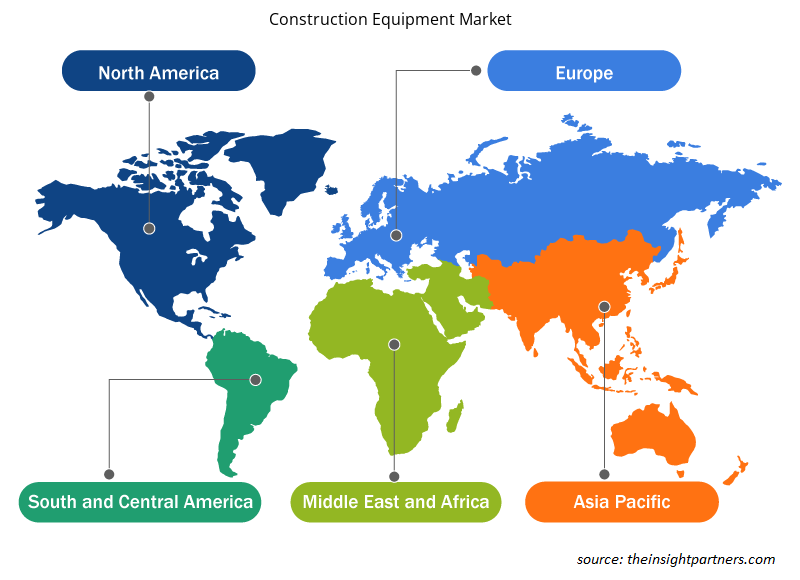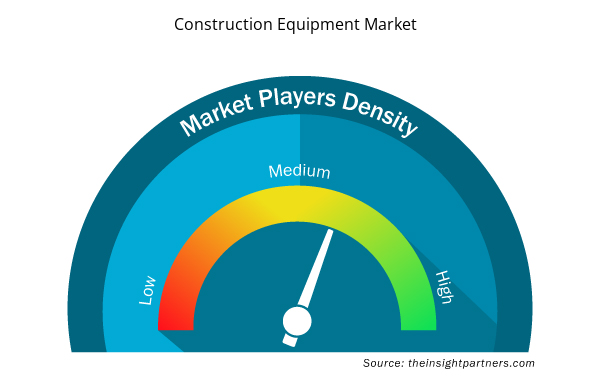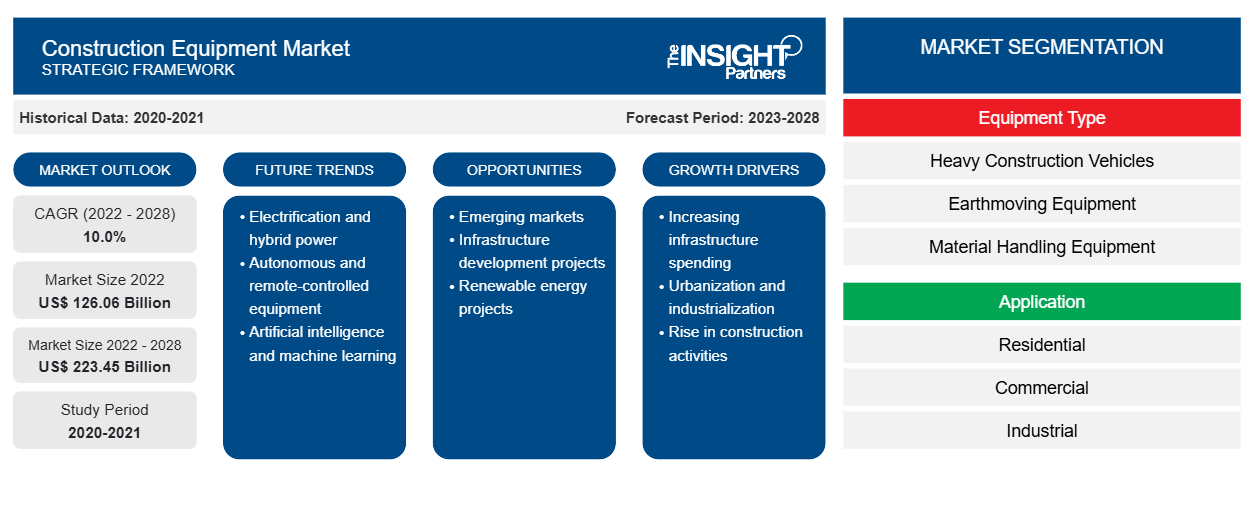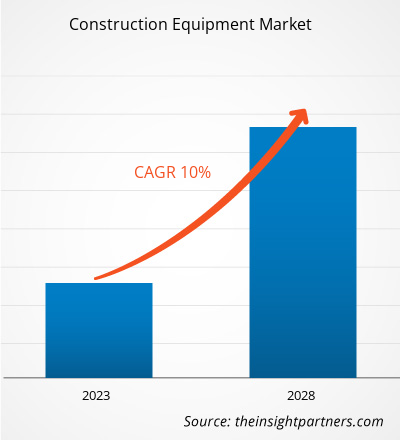建設機械市場は、2022年の126,062.8百万米ドルから2028年には223,451.1百万米ドルに成長すると予想されており、 2022年から2028年にかけて10.0%のCAGRで成長すると予測されています。
建設作業、最も一般的には土工作業を行うために特別に開発された大型車両は、建設機械と呼ばれます。適切な機器を適切に使用することで、プロジェクトの経済性、品質、安全性、速度、適時性が向上します。請負業者がプロジェクトに必要なすべての建設機械を所有することが常に望ましく、実現可能であるとは限りません。掘削、土の掘削、長距離の移動、配置、締め固め、均し、ドーザー、整地、運搬は、あらゆる建設プロジェクトの建設に含まれる主要なプロセスです。掘削や地面の移動などのさまざまな掘削作業は、土工機械
を使用して実行されます。土工機械にはさまざまな形やサイズがあります。これらは主に、修理、建設、持ち上げ、農業、解体の目的で使用されます。掘削機は、バケット、アーム、回転キャブ、可動式トラックを備えた土工機械です。バックホーは、リアアクターまたはバックディガーとも呼ばれ、2 つの部分からなる関節式アームの先端に掘削バケットが取り付けられた掘削装置の一種です。ローダーは、アスファルト、解体廃棄物、土、雪、飼料、砂利、丸太、未加工の鉱物、リサイクル材料、岩、砂、木材チップなどの資材を別の種類の機械に移動または積み込む建設機械です。
要件に合わせてレポートをカスタマイズする
このレポートの一部、国レベルの分析、Excelデータパックなど、あらゆるレポートを無料でカスタマイズできます。また、スタートアップや大学向けのお得なオファーや割引もご利用いただけます。
- このレポートの主要な市場動向を入手してください。この無料サンプルには、市場動向から見積もりや予測に至るまでのデータ分析が含まれます。
建設機械市場の主要な利害関係者は、建設機械の原材料、供給側で活動する建設機械メーカー、および需要側で活動する建設機械のエンドユーザーです。近年、特に住宅および商業建設における建設機械の需要が増加しており、今後5年間で建設機械市場の成長を牽引すると予想されています。キャタピラー、ジョンディア、コマツ、ボルボ、リープヘルは、主要な建設機械プロバイダーです。これらの主要なエコシステムプレーヤーに加えて、テクノロジーの進歩と複数の業界でのこれらの製品の採用を可能にする上で重要な役割を果たしている他の多くの周辺利害関係者がいます。
COVID-19パンデミックが建設機械市場に与える影響
2020年、COVID-19パンデミックは建設活動を妨げました。その結果、建設機械の販売は世界中で減少しました。インフラ投資、住宅、商業、産業建設、地下および井戸建設、および制度的支出は、建設機械メーカーに影響を与えています。米国、英国、中国、インドは、不釣り合いな影響を受けている国の中にあります。国際建設グループによると、2020年にはすべてのプロジェクトの4分の1以上(22.7%)の納品が250日以上遅れ、すべてのプロジェクトの10分の1以上(13.4%)が1年以上遅れました。ただし、病院やその他の医療施設、研究所、および輸送および物流インフラのプロジェクトは供給が限られています。さらに、いくつかの国では、建設業界を含むさまざまな産業の活動を徐々に再開し始めています。インドと中国は、工業および商業建設プロジェクトを開始しました。2021年4月、各国が新しいプロジェクトの実施を開始したため、工業生産は2021年1月以来初めて上昇しました。そのため、掘削機、バックホーローダー、コンパクター、ドーザーなどの建設機械の需要が急増しました。
市場洞察
COVID-19パンデミック後のインフラ投資の増加
COVID-19パンデミックにより、世界中の経済活動は大幅に抑制されました。2020年から2021年にかけてインフラへの巨額の投資が行われ、インフラ産業の成長に弾みがつきました。発電、国道建設、鉄道、海上貨物へのインフラ投資が建設機械の需要を押し上げています。新興国では、石炭、原油、鉄鋼、セメントなど、いくつかの中核インフラ産業が2021年に成長指数を示しました。これらの要因が建設機械市場の成長にプラスの影響を与えました。インフラ投資は製品開発に長期的な影響を及ぼし、その影響の規模は不明ですが、長期的にはGDPを押し上げる可能性があります。特に中東のほとんどの国は、地域のインフラ開発プロジェクトに焦点を当てた4か国経済フォーラムを設立しています。従業員間および消費者とのコミュニケーションを促進するために、企業はデジタルソリューションとチャネルを使用しています。政府や教育機関も同様に取り組んでいます。
機器タイプセグメントの分析
商業、住宅、産業プロジェクトの増加により、作業完了に強力なツールや機械を必要とするため、これまで以上に多くの建設機械が使用されています。 大規模なプロジェクトでは、さまざまな作業に大型建設機械が使用されます。 大型機械の種類の選択は、プロジェクトの範囲とコストに基づいて行われます。 これらの要素により、建設プロセスが容易になり、スピードアップします。 掘削機は、建設分野で重要かつ頻繁に使用される機械です。
アプリケーションセグメントの洞察
建設機械市場は、用途に基づいて、住宅用、商業用、および産業用に分割されています。アスファルトミキシングプラントと呼ばれる建設ツールは、道路建設プロジェクトで使用するためのコーティングされたロードストーンやその他の種類のアスファルトコンクリートを製造するために使用されます。ロードローラーは、基本的に、道路や基礎を建設する際に土、砂利、コンクリート、またはアスファルトを押し下げるコンパクタースタイルのエンジニアリングマシンです。高層ビルや深い基礎を必要とするその他の巨大な工業団地にプレキャスト杭を設置するために、杭打ち機を使用して建設現場で垂直の穴を開け、建設機械市場の成長をもたらしています。
建設機械市場のプレーヤーは、競合他社と競争するために、高度なテクノロジーと機能を統合することにより、新製品の革新と開発に重点を置いています。2022年6月、キャタピラー社は、世界本社をイリノイ州ディアフィールドからテキサス州アービングの既存の施設に移転すると発表しました。同社は2022年に本社をアーヴィングに移転し始める予定です。
建設機械市場は、機器の種類に基づいて、大型建設車両、土木機械、資材搬送機器、その他に分類されています。市場は、用途に基づいて、住宅用、商業用、産業用に分かれています。地域に基づいて、世界の建設機械市場は、北米、ヨーロッパ、アジア太平洋、中東およびアフリカ、南米に分かれています。
建設機械市場の地域別分析
予測期間を通じて建設機械市場に影響を与える地域的な傾向と要因は、Insight Partners のアナリストによって徹底的に説明されています。このセクションでは、北米、ヨーロッパ、アジア太平洋、中東、アフリカ、南米、中米にわたる建設機械市場のセグメントと地理についても説明します。

- 建設機械市場の地域別データを入手
建設機械市場レポートの範囲
| レポート属性 | 詳細 |
|---|---|
| 2022年の市場規模 | 1,260.6億米ドル |
| 2028年までの市場規模 | 2,234.5億米ドル |
| 世界のCAGR(2022年 - 2028年) | 10.0% |
| 履歴データ | 2020-2021 |
| 予測期間 | 2023-2028 |
| 対象セグメント | 機器タイプ別
|
| 対象地域と国 | 北米
|
| 市場リーダーと主要企業プロフィール |
|
建設機械市場のプレーヤー密度:ビジネスダイナミクスへの影響を理解する
建設機械市場は、消費者の嗜好の変化、技術の進歩、製品の利点に対する認識の高まりなどの要因により、エンドユーザーの需要が高まり、急速に成長しています。需要が高まるにつれて、企業は提供を拡大し、消費者のニーズを満たすために革新し、新たなトレンドを活用し、市場の成長をさらに促進しています。
市場プレーヤー密度とは、特定の市場または業界内で活動している企業または会社の分布を指します。これは、特定の市場スペースに、その市場規模または総市場価値に対してどれだけの競合相手 (市場プレーヤー) が存在するかを示します。
建設機械市場で事業を展開している主要企業は次のとおりです。
- キャタピラー社
- CNHインダストリアルNV
- コマツ株式会社
- リープヘル
- テレックスコーポレーション
免責事項:上記の企業は、特定の順序でランク付けされていません。

- 建設機械市場のトップキープレーヤーの概要を入手
建設機械市場 – 企業プロファイル
- キャタピラー社
- CNHインダストリアルNV
- 日立建機株式会社
- JC バンフォード エクスカベーターズ株式会社
- ディア・アンド・カンパニー
- コマツ
- リープヘル インターナショナル ドイチュランド GmbH
- テレックスコーポレーション
- ボルボCE
- ズームライオン重工科学技術株式会社
- 過去2年間の分析、基準年、CAGRによる予測(7年間)
- PEST分析とSWOT分析
- 市場規模価値/数量 - 世界、地域、国
- 業界と競争環境
- Excel データセット



Report Coverage
Revenue forecast, Company Analysis, Industry landscape, Growth factors, and Trends

Segment Covered
This text is related
to segments covered.

Regional Scope
North America, Europe, Asia Pacific, Middle East & Africa, South & Central America

Country Scope
This text is related
to country scope.
よくある質問
Asia-Pacific dominated the Construction Equipment Market in 2021 with a share of 36.0%; it would continue to dominate the market during the forecast period and account for 38.4% share by 2028
The global construction equipment market size is projected to reach US$ 223451.09 million by 2028.
The material handling equipment segment led the construction equipment market in 2021.
APAC is the fastest-growing regional market in the global construction equipment market in 2021.
The key players holding the major market share of the construction equipment market are Caterpillar, Komatsu, VOLVO Construction Equipment, John Deere and Liebherr.
The Future trends impacting the construction equipment market are -- Growing Demand for the Artificial Intelligence
The global construction equipment market was valued at US$ 120661.95 million in 2021
The driving factors impacting the construction equipment market are
I. Increasing Infrastructure Investments Post COVID-19 Pandemic
Growing Focus on Public-Private Partnerships (PPP)
Trends and growth analysis reports related to Manufacturing and Construction : READ MORE..
The List of Companies -Construction Equipment Market
- Caterpillar Inc
- CNH Industrial N.V.
- Komatsu Ltd
- Liebherr
- Terex Corporation
- Zoomlion Heavy Industry Science&Technology Co., Ltd.
- J C Bamford Excavators Ltd. (JCB)
- Deere & Company
- AB Volvo
- Hitachi Construction Machinery Co., Ltd.
The Insight Partners performs research in 4 major stages: Data Collection & Secondary Research, Primary Research, Data Analysis and Data Triangulation & Final Review.
- Data Collection and Secondary Research:
As a market research and consulting firm operating from a decade, we have published and advised several client across the globe. First step for any study will start with an assessment of currently available data and insights from existing reports. Further, historical and current market information is collected from Investor Presentations, Annual Reports, SEC Filings, etc., and other information related to company’s performance and market positioning are gathered from Paid Databases (Factiva, Hoovers, and Reuters) and various other publications available in public domain.
Several associations trade associates, technical forums, institutes, societies and organization are accessed to gain technical as well as market related insights through their publications such as research papers, blogs and press releases related to the studies are referred to get cues about the market. Further, white papers, journals, magazines, and other news articles published in last 3 years are scrutinized and analyzed to understand the current market trends.
- Primary Research:
The primarily interview analysis comprise of data obtained from industry participants interview and answers to survey questions gathered by in-house primary team.
For primary research, interviews are conducted with industry experts/CEOs/Marketing Managers/VPs/Subject Matter Experts from both demand and supply side to get a 360-degree view of the market. The primary team conducts several interviews based on the complexity of the markets to understand the various market trends and dynamics which makes research more credible and precise.
A typical research interview fulfils the following functions:
- Provides first-hand information on the market size, market trends, growth trends, competitive landscape, and outlook
- Validates and strengthens in-house secondary research findings
- Develops the analysis team’s expertise and market understanding
Primary research involves email interactions and telephone interviews for each market, category, segment, and sub-segment across geographies. The participants who typically take part in such a process include, but are not limited to:
- Industry participants: VPs, business development managers, market intelligence managers and national sales managers
- Outside experts: Valuation experts, research analysts and key opinion leaders specializing in the electronics and semiconductor industry.
Below is the breakup of our primary respondents by company, designation, and region:

Once we receive the confirmation from primary research sources or primary respondents, we finalize the base year market estimation and forecast the data as per the macroeconomic and microeconomic factors assessed during data collection.
- Data Analysis:
Once data is validated through both secondary as well as primary respondents, we finalize the market estimations by hypothesis formulation and factor analysis at regional and country level.
- Macro-Economic Factor Analysis:
We analyse macroeconomic indicators such the gross domestic product (GDP), increase in the demand for goods and services across industries, technological advancement, regional economic growth, governmental policies, the influence of COVID-19, PEST analysis, and other aspects. This analysis aids in setting benchmarks for various nations/regions and approximating market splits. Additionally, the general trend of the aforementioned components aid in determining the market's development possibilities.
- Country Level Data:
Various factors that are especially aligned to the country are taken into account to determine the market size for a certain area and country, including the presence of vendors, such as headquarters and offices, the country's GDP, demand patterns, and industry growth. To comprehend the market dynamics for the nation, a number of growth variables, inhibitors, application areas, and current market trends are researched. The aforementioned elements aid in determining the country's overall market's growth potential.
- Company Profile:
The “Table of Contents” is formulated by listing and analyzing more than 25 - 30 companies operating in the market ecosystem across geographies. However, we profile only 10 companies as a standard practice in our syndicate reports. These 10 companies comprise leading, emerging, and regional players. Nonetheless, our analysis is not restricted to the 10 listed companies, we also analyze other companies present in the market to develop a holistic view and understand the prevailing trends. The “Company Profiles” section in the report covers key facts, business description, products & services, financial information, SWOT analysis, and key developments. The financial information presented is extracted from the annual reports and official documents of the publicly listed companies. Upon collecting the information for the sections of respective companies, we verify them via various primary sources and then compile the data in respective company profiles. The company level information helps us in deriving the base number as well as in forecasting the market size.
- Developing Base Number:
Aggregation of sales statistics (2020-2022) and macro-economic factor, and other secondary and primary research insights are utilized to arrive at base number and related market shares for 2022. The data gaps are identified in this step and relevant market data is analyzed, collected from paid primary interviews or databases. On finalizing the base year market size, forecasts are developed on the basis of macro-economic, industry and market growth factors and company level analysis.
- Data Triangulation and Final Review:
The market findings and base year market size calculations are validated from supply as well as demand side. Demand side validations are based on macro-economic factor analysis and benchmarks for respective regions and countries. In case of supply side validations, revenues of major companies are estimated (in case not available) based on industry benchmark, approximate number of employees, product portfolio, and primary interviews revenues are gathered. Further revenue from target product/service segment is assessed to avoid overshooting of market statistics. In case of heavy deviations between supply and demand side values, all thes steps are repeated to achieve synchronization.
We follow an iterative model, wherein we share our research findings with Subject Matter Experts (SME’s) and Key Opinion Leaders (KOLs) until consensus view of the market is not formulated – this model negates any drastic deviation in the opinions of experts. Only validated and universally acceptable research findings are quoted in our reports.
We have important check points that we use to validate our research findings – which we call – data triangulation, where we validate the information, we generate from secondary sources with primary interviews and then we re-validate with our internal data bases and Subject matter experts. This comprehensive model enables us to deliver high quality, reliable data in shortest possible time.


 このレポートの無料サンプルを入手する
このレポートの無料サンプルを入手する